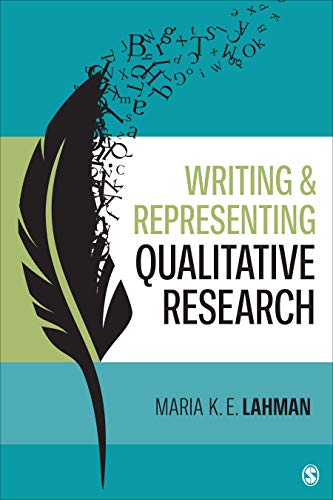图书简介
This book addresses foundational areas of qualitative writing (such as journal articles and dissertations), aesthetic representations (including poetry and autoethnography), publishing, and reflexivity in representation in one practical and engaging text based on real experiences. Author Maria K.E. Lahman draws on her experiences as a qualitative research professor and writing instructor, and as someone who has published widely in scholarly journals, employing both traditional and more innovative forms of writing. The first part of the book covers writing tips; how to represent data; how to write a qualitative thematic journal article; how to write a qualitative dissertation; and provides guidance on the publication process. The second part encourages the qualitative researcher to move beyond traditional forms of writing and consider how qualitative research can be represented more aesthetically: as poems, autoethnographies, and visually. The book concludes with a chapter on reflexivity in research representations. Throughout, the author provides vivid examples from her own work, and that of graduate students and colleagues.
Preface \\ Acknowledgments \\ About the Author \\ PART I. WRITING QUALITATIVE RESEARCH ESSENTIALS \\ Chapter 1. Introduction \\ Literary Framing \\ Path of the Book \\ Features of the Book \\ The Gist \\ Reflexive Questions \\ Chapter 2. Why, What, and How We Write \\ Why Do We Write? \\ What Do We Write? \\ How Do We Write? \\ The Gist: Get on With It \\ Reflexive Questions \\ Reflexive Activities \\ Resources \\ Chapter 3. Start Writing! \\ Data Represented in Three Ways: An Exemplar \\ Honing the Craft of Writing \\ The Gist \\ Reflexive Questions \\ Reflexive Activities \\ Resources \\ Chapter 4. Qualitative Dissertations: The Three Rules \\ The Dissertation Proposal (or Chapters 1–3) \\ The Dissertation (or Chapters 4 and 5) \\ Politics and Process of the Dissertation \\ Change Is in the Wind \\ The Gist \\ Reflexive Questions \\ Resources \\ Chapter 5. Writing the Qualitative Journal Article: Of Rice Cakes, Tortillas, Bread, and Butter \\ Before the Formal Writing \\ The Qualitative Thematic Article: Bread and Butter of Qualitative Research \\ The Methodological Article \\ The Gist \\ Reflexive Questions \\ Resources \\ Reflexive Activities \\ Chapter 6. Publish and Persevere: The Publication Process \\ Getting Organized \\ Preparing the Manuscript for Publication \\ Submission \\ Anticipating the Reviews \\ The Review \\ Revise and Resubmit \\ Reject \\ Accept, and Accept With Revisions \\ Production \\ Done, Done, Done! (Not Really): Promoting Publication \\ Get Started Promoting Your Publication \\ The Gist \\ Reflexive Questions \\ Reflexive Activities \\ Resources \\ PART II. AESTHETIC REPRESENTATIONS OF QUALITATIVE RESEARCH \\ Chapter 7. Autoethnography: A Kaleidoscope of Knowing \\ Background of Autoethnography \\ Major Genres of Autoethnography \\ One Way to Create Autoethnography \\ Tensions in Autoethnography \\ The Gist \\ Reflexive Questions \\ Reflexive Activities \\ Resources \\ Chapter 8. Poemish Research Representations \\ Why Poetry? \\ Forms of Research Poetry \\ Ideas for Forging Research Poetry \\ Poetic Tensions \\ The Gist \\ Reflexive Questions \\ Reflexive Activities \\ Resources \\ Chapter 9. Visuals in Qualitative Research Representation: In the Blink of an Eye \\ Visual Inquiry Background \\ Exemplars of Visual Research Representations \\ Representing Visuals \\ Considerations for Visual Representations \\ The Gist \\ Reflexive Questions \\ Reflexive Activities \\ Resources \\ Chapter 10. Reflecting Reflexivity in Research Representations \\ What Is Reflexivity? \\ Traditional Reflexivity Representations \\ Contemporary Reflexivity: Undergirding Representations \\ The Gist \\ Reflexive Questions \\ Reflexive Activities \\ Resources \\ Epilogue \\ Appendices \\ Appendix A. A Sample Syllabus From a Graduate-Level Qualitative Research Writing Course \\ Appendix B. An Example of a Doctoral Student Representing the Same Data Set in Three Different Ways \\ Appendix C. Reflexive Activities for Novice and Sage Writers \\ Appendix D. Tips for Writing and Presenting a Research Poster \\ Appendix E. Writing Prompts \\ References \\ Index
Trade Policy 买家须知
- 关于产品:
- ● 正版保障:本网站隶属于中国国际图书贸易集团公司,确保所有图书都是100%正版。
- ● 环保纸张:进口图书大多使用的都是环保轻型张,颜色偏黄,重量比较轻。
- ● 毛边版:即书翻页的地方,故意做成了参差不齐的样子,一般为精装版,更具收藏价值。
关于退换货:- 由于预订产品的特殊性,采购订单正式发订后,买方不得无故取消全部或部分产品的订购。
- 由于进口图书的特殊性,发生以下情况的,请直接拒收货物,由快递返回:
- ● 外包装破损/发错货/少发货/图书外观破损/图书配件不全(例如:光盘等)
并请在工作日通过电话400-008-1110联系我们。
- 签收后,如发生以下情况,请在签收后的5个工作日内联系客服办理退换货:
- ● 缺页/错页/错印/脱线
关于发货时间:- 一般情况下:
- ●【现货】 下单后48小时内由北京(库房)发出快递。
- ●【预订】【预售】下单后国外发货,到货时间预计5-8周左右,店铺默认中通快递,如需顺丰快递邮费到付。
- ● 需要开具发票的客户,发货时间可能在上述基础上再延后1-2个工作日(紧急发票需求,请联系010-68433105/3213);
- ● 如遇其他特殊原因,对发货时间有影响的,我们会第一时间在网站公告,敬请留意。
关于到货时间:- 由于进口图书入境入库后,都是委托第三方快递发货,所以我们只能保证在规定时间内发出,但无法为您保证确切的到货时间。
- ● 主要城市一般2-4天
- ● 偏远地区一般4-7天
关于接听咨询电话的时间:- 010-68433105/3213正常接听咨询电话的时间为:周一至周五上午8:30~下午5:00,周六、日及法定节假日休息,将无法接听来电,敬请谅解。
- 其它时间您也可以通过邮件联系我们:customer@readgo.cn,工作日会优先处理。
关于快递:- ● 已付款订单:主要由中通、宅急送负责派送,订单进度查询请拨打010-68433105/3213。
本书暂无推荐
本书暂无推荐















